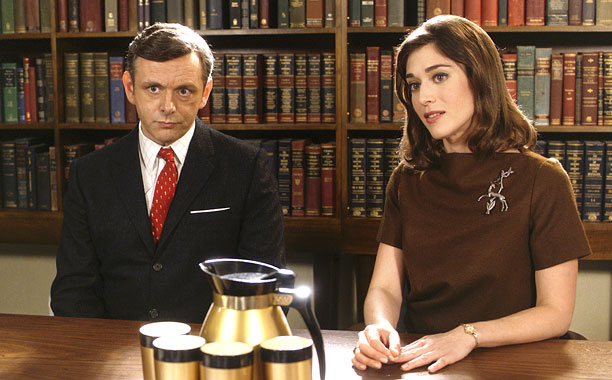Last Year at Marienbad
Directed by Alain Resnais
Written by Alain Robbe-Grillet
France, 1961
Where Alain Resnais’ first film, Hiroshima mon amour, was the unconventional story of two people haunted by the imagery of a distant war, his follow-up, Last Year at Marienbad, expanded upon the themes of troubled memory and the imagined past in a convoluted series of conversation and flashbacks between a woman and two men, all unnamed. Famous for its confounding narrative structure, the film excels at making truth and fiction indistinguishable. Its surreal, dream-like nature is at once fascinating and baffling, prompting some to call the film a masterpiece and others incomprehensible. Encompassing all the passion and pain of a love triangle and the intrigue of a mystery, Last Year at Marienbad maintains its outwardly staid atmosphere throughout to haunting effect.
The film begins at a social gathering at a château when a man (Giorgio Albertazzi) approaches a woman (Delphine Seyrig), claiming that they met the year before at Marienbad. He is convinced that she is there waiting for him. The woman insists that she has no memory of this, that they have never met. A second man (Sacha Pitoëff), who may or may not be the woman’s husband or lover, unquestionably exercises authority over her and asserts his dominance over the first man, including beating him several times at Nim, a challenging mathematical game of wits. The relationships between these characters are explored throughout the film in flashbacks and disorienting shifts in time and location. Over the course of what might be days, weeks, or years, the man’s words draw her out of her stupor until she too shares his memories – or is it fantasies – of their affair at Marienbad.
As in Hiroshima mon amour, Resnais makes extensive use of repetition. Entire conversations and even events repeat themselves in several places around the château. This technique only adds to the confusion of time and place, fact and fiction. Have these events occurred before or are they pure fantasy? Perhaps in the repetition of these events, or rather the repetition of his stories and memories of their affair, he gradually restores her memory and convinces her of his sincerity. He reminds her of the moments they shared, their conversations, their plans to meet, her desire to wait one year, and her promise to see him again next summer. Yet seemingly identical events are frequently repeated but with alternate endings. He tells her of a shooting and a death only to correct himself. There was no pistol. It didn’t happen that way.
Narrated by this mysterious, persuasive man, with scant dialogue from the other characters, the film itself begins to convince us of his alleged previous relationship with the woman. She says she doesn’t remember him, but she clearly cares about his version of events. At times, they even appear to be lovers. This points to one of the most interesting interpretations of the film: that this strange man is, in fact, constructing the entire narrative. He is the author of this story. When he speaks, the other characters obediently reflect his latest tale. There is a distinct lack of causality in these characters’ actions. They behave as he says they do: her lover discovers them together, then doesn’t; he fires a pistol and doesn’t fire it. We see the woman in white and in black, alive and dead. The film constructs a space in which any eventuality can be explored. Like any creator, any writer, this man creates his characters and tells them what to do. When he doesn’t like that, he changes his mind and orders them to do it differently.
No matter how you interpret the film, there remains an absence of any lucid explanation of the characters’ actions. That is the brilliance of Resnais and screenwriter Alain Robbe-Grillet, to all but ignore traditional narrative relations of cause and effect and conventional motivation and plot. The result is an undeniably unique experience – a surrealist vision of a romantic encounter at a château between a man and the woman he must convince had promised one year ago to meet him there.
– Katherine Springer






